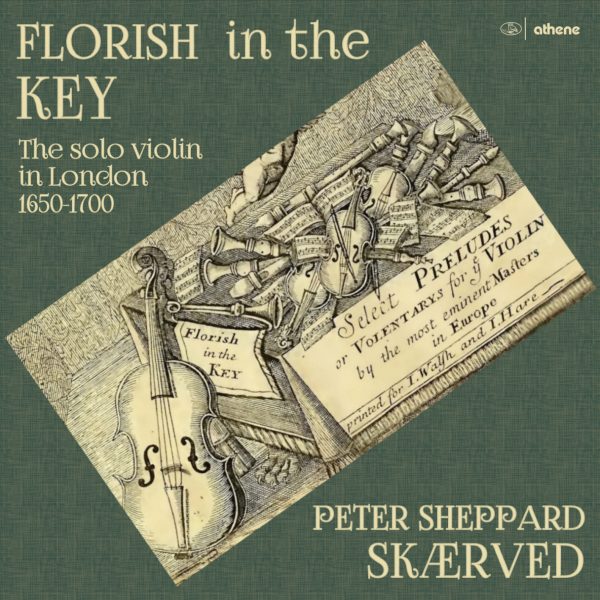Infodad
Sometimes the main reason to listen to a CD is to hear the way the instruments on it are played – not to hear the specific music for which those instruments are employed. A new Athene disc is of this type: the playing by Peter Sheppard Skærved is excellent; the violin used for most of the recording, which dates to 1664 but whose maker is unknown, has a warm and full-bodied sound that is instantly attractive; a second violin, used for a subset of the material, is an absolutely wonderful, even-toned Girolamo Amati instrument from 1629; the composers represented are a kind of “who’s who” of the Baroque era; and the CD’s length of almost an hour and a quarter is generous.
However, all these positives are at the service of works that are, truth be told, by and large not terribly interesting. The disc has 44 tracks, with pieces ranging in length from 48 seconds to (in a single case) nearly four minutes; most of these little works are in the one-to-two-minute range. The majority come from a 1705 collection of Preludes & Voluntarys, with 10 (the ones for which the Amati is used) being composed by Thomas Baltzar (c. 1630-1664) – arguably the most-famous violinist of his time.
Among the many other composers represented here are Corelli, Torelli, Biber, Albinoni, Pepusch, and Purcell – and there are also works by composers now known only by their last names: Mr. Dean, Mr. Simons, Mr. Smith, and Mr. Hills (they were presumably court musicians). What is noteworthy is the uniformly high quality of the material: every single composer was clearly skilled at writing for solo violin, exploring the instrument’s capabilities within a constricted length, and there is little to distinguish the preludes by the virtually unknown composers from those of the more-famous ones.
Skærved, a strong advocate for music of this time period, treats every work here with respect and explores the repertoire with care as well as skill. And it is certainly interesting, from a historical perspective, to learn that there were so many fine composers flourishing at this time and producing works exploring the violin’s capabilities. But the fact remains that nothing here is of any outstanding musical interest in and of itself. Short prelude follows short prelude, with differing keys and tempos but little chance for the composers to establish individuality or produce any work of significance. The Baltzar material is the most interesting, simply because there is enough of it (more than 20 minutes in all) to provide a sense of Baltzar’s compositional and performance skills.
But the main focus here, other than history, is the sound of the two violins that Skærved plays – which means that listeners interested in differences among violins, even ones of the same era, will find this material intriguing. On a strictly musical basis, however, the disc is very thin indeed and unlikely to appeal to many people other than violinists or dedicated students of 17th-century string music.
@divineartrecordingsgroup
A First Inversion Company
Registered Office:
176-178 Pontefract Road, Cudworth, Barnsley S72 8BE
+44 1226 596703
Fort Worth, TX 76110
+1.682.233.4978




![Listen to the full suite of Marcel Dupré’s Variations Sur un Noël, Op. 20 from Alexander Ffinch’s #Expectations release today! listn.fm/expectations [in bio]](https://scontent-dfw5-1.cdninstagram.com/v/t51.71878-15/588904367_2327488161082898_8709236950834211856_n.jpg?stp=dst-jpg_e35_tt6&_nc_cat=105&ccb=7-5&_nc_sid=18de74&efg=eyJlZmdfdGFnIjoiQ0xJUFMuYmVzdF9pbWFnZV91cmxnZW4uQzMifQ%3D%3D&_nc_ohc=6Hmi-5Sxz4wQ7kNvwEKF_cg&_nc_oc=AdmfUev2Z4pE3LqBImMuI7-2kCwwMYVrTqQbm0tL5EYpT7CaQMzIBZMcmz5fZmMH-W8&_nc_zt=23&_nc_ht=scontent-dfw5-1.cdninstagram.com&edm=ANo9K5cEAAAA&_nc_gid=1umDds_DSRvmiKhxpGZYQQ&oh=00_AfmirKuD4uu7qCIyPjr1m6uyGsONx_Ntl1scRGAbbPL4dA&oe=694364AA)

![“the ‘Manteca’ Paraphrase – a rare foray into the two-piano medium but here played double-tracked – exudes a panache of which Dizzy Gillespie would surely have approved.… [a] recital well worth investigating.” —Gramophone Magazine with high praise for Ophelia Gordon's debut release, Kapustin: Between the Lines!](https://scontent-dfw5-3.cdninstagram.com/v/t51.82787-15/598796470_18303255136283342_540941604740887837_n.jpg?stp=dst-jpg_e35_tt6&_nc_cat=108&ccb=7-5&_nc_sid=18de74&efg=eyJlZmdfdGFnIjoiRkVFRC5iZXN0X2ltYWdlX3VybGdlbi5DMyJ9&_nc_ohc=6FiEgYiNOZUQ7kNvwGh4i_d&_nc_oc=Adk99BfMJCNGctqW4iHb2N7CLKX1MusvVFMVOw8LIyLZ8XWZmZbY-3dsF18K5b7tnwQ&_nc_zt=23&_nc_ht=scontent-dfw5-3.cdninstagram.com&edm=ANo9K5cEAAAA&_nc_gid=1umDds_DSRvmiKhxpGZYQQ&oh=00_Afk8y0aNixT2Tyxc8g3LW70PJcF3IkicWIp1NCg72OEbBg&oe=69437744)





